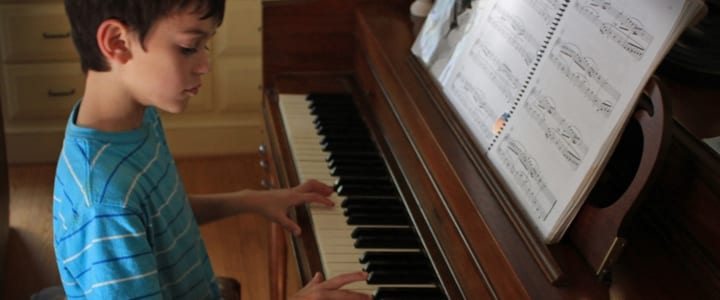No matter which piano method your instructor teaches, there are certain basics you need to know to avoid injuries and continue playing for years to come! Here, Chicago music teacher Sarah H. reviews the basics to remember…
No one said that learning the piano would be easy, but you’re up for the challenge. After all, if you ask how to get to Carnegie Hall, the answer will most likely be “Practice! Practice! Practice!” But what happens when all of that well-intentioned practicing seems like it’s doing more harm than good? Relax and take a step back. Here are a few things you can do to help eliminate stress and prevent injury while playing the piano:
Setting Yourself Up for Success
First thing’s first! Set up your practice space so that playing your piano is enjoyable. This space should encompass a kind of musical Zen that supports productivity, artistry, and good playing habits. Here are some simple tips that can make a huge impact on your practicing:
- Keep your piano in a quiet area of your home away from extra distractions such as television, computers, and social areas.
- Anything you need during your playing sessions should be easily accessible. This includes music, a pencil, a metronome, your lesson book, and anything else you might need. This saves time, stress, and extra interruptions during your practicing.
- Provide yourself with enough lighting to see your music easily. Practicing in a dark room is tiring on your eyes and your mind! Reading music without sufficient lighting strains the muscles of the eyes and can cause headaches.
- A pianist’s bench is your most valuable piece of equipment. Because pianists sit with no back support, they are at a higher risk for strain and injury. To keep your back healthy while playing, adjust the height of your bench or chair so that your hips are slightly higher than your knees when sitting. This aligns the pelvis in a way that promotes the natural lumbar curve of the lower spine and relaxes the muscles of the lower back.
Let’s Talk Practicing: Creating a Routine
Now that you have your playing space set up, your next step is to establish a practice routine. Your teacher is a great resource in helping you create this routine, but these tips will give you a good foundation:
- Consistency is the name of the game! Try to keep the amount of time you play every day consistent. Don’t fret if you miss a day of practicing here and there, but never try to “catch up” on missed sessions by adding on to another day.
- Think like an athlete in training. In many ways, practicing the piano is very similar to preparing for an endurance event. A runner trains for a marathon over several months, only increasing their distance and speed in small amounts. In much the same way, any changes to your practice routine should be gradual.
- If you have the option, break up a longer session into two or three shorter ones throughout the day. Short, frequent practice sessions will not only help you retain information, but will decrease your risk of an overuse injury.
Warming Up, Cooling Down, and Everything in Between
Just like an athlete, you decrease your risk for injury by warming up and cooling down each time you play. Some piano methods, such as the Alexander Technique, place special emphasis on reducing tension through stretching. Especially during the cold winter months, it’s important to raise the body’s core temperature and get the blood flowing before working any muscle groups (including our arms and hands). Try incorporating some of these warm-ups and stretches into your next practice session:
- Warm up away from the piano first. Start with the largest muscle groups (legs, shoulders, back) and move to the arms and hands. Here are some warm-ups to get you started:
- Squats 10-15 reps
- Arm raises 15-20 reps: Raise arms laterally to shoulder height, and then relax to sides.
- Shoulder shrugs 15-20 reps
- Scapular retraction 15-20 reps: Pinch shoulder blades together, and then relax.
- Arm circles 20 reps: With arms out to sides, gently rotate clockwise, then counter-clockwise.
- Wrist flexion and extension 20 reps: Gently flex the wrist down, and then move back to neutral. Repeat and extend the wrist up.
- Finger flexion and extension 10 reps: Make a fist, then open the hand and spread the fingers.
- Practice smart. Don’t mindlessly repeat difficult or exhausting sections of music over and over without a goal in mind. Vary your repertoire when practicing.
- Take breaks! Allow yourself to get up, walk around, and stretch at least every 30-45 minutes.
- Cool down – gently stretch your arms, shoulders, back, neck, and legs after you are finished practicing.
Knowing When to Stop: Common Injuries and How to Avoid Them
Playing the piano is certainly challenging, but it should never hurt. If you ever feel pain while playing, stop! Pain or discomfort are the body’s way of telling us that something could be wrong. Let’s talk about some common injuries, their warning signs, and how to avoid them.
Back and Neck
Periods of sitting in poor or awkward postures cause stress on the spine and the muscles of the back and neck. Muscles are “happiest” when they are in the midpoint of their full range of motion. Holding a static position or contraction reduces blood flow to the muscles and is extremely fatiguing. Over time, long periods of static loading can strain the muscles and tendons of the back and cause disc problems.
Warning Signs:
-Pain or discomfort in the neck, lower back, or hips
-Fatigue
How to Avoid it:
- Get up and move at least every 30-45 minutes while practicing. Even while sitting, allow yourself to move your back, legs, and arms every few minutes.
- Do your best to maintain a neutral position in your torso, neck, legs, and arms while playing. Be aware of any unnecessary bending, twisting, leaning, or rotating. If you have a tendency to look at your hands while playing, practice just looking with your eyes instead of your entire head.
- Practice good posture. Sit near the edge of your seat with your hips slightly higher than your knees. Move yourself close enough to the piano so you don’t need to lean forward to reach the keys. Keep your shoulders down and drawn back.
- Do activities or exercises that strengthen your core muscles. Swimming, running, and yoga are great for building endurance and core strength.
Shoulders
Because all of the action of piano playing happens in front of the body, the shoulders sometimes become stiff, fatigued, and sore. Although pianists are at a significantly lower risk for shoulder injuries than some other instrumentalists, playing for long periods of time can definitely cause some significant discomfort. Here are some things you can do to promote healthy and happy shoulders:
- Be aware of your shoulder position while you are playing. Be sure not to hunch or raise your shoulders.
- Take breaks to stretch the pectoral (chest) muscles. These muscles tend to get tight and stiff when playing for long periods of time.
- Strengthen the muscles of your shoulders and upper back. Simple exercises such as arm raises, shoulder shrugs, and rowing strengthen important postural and stabilizer muscles.
Arms and Wrists
Overuse and nerve entrapment injuries of the arms and wrists are of the most common injuries for pianists, including: tendonitis (swelling of the connective tissue), bursitis (the swelling of the bursa), and in some cases carpal tunnel syndrome (the compression of the medial nerve at the wrist). Although there are several different factors that put a person at risk for these conditions, the high repetition of fine motor movements is the primary cause for musicians.
Warning Signs:
-Pain or discomfort
-Fatigue or weakness
-Numbness or tingling
-Limited movement or dexterity
-Stiffness
-Difficultly with normal daily activities such as opening bottles and twisting doorknobs
How to Avoid it:
- Warm up thoroughly before practicing
- Maintain a neutral and relaxed hand position while playing
- Avoid unnecessary repetition of fast or strenuous passages
- Limit the amount of unnecessary texting, typing, and writing you do throughout the day. These activities can be just as strenuous as playing.
What to Do When the Worst Happens:
- STOP! If you have any of the above warning signs or are ever in pain while playing, stop right away.
- Rest. Sometimes all you need is a few days off of playing. Always be sure to gently ease back into practicing after a break.
- Ice. Using a thin towel as a buffer, apply ice to the affected area for about 10 minutes. Doing this several times a day will help decrease swelling and pain and promotes healing. Never play or stretch right after you use ice, as your muscles are less flexible right after icing. Be cautious if you have circulatory issues or other conditions that may be affected by the use of ice packs.
- Seek professional medical advice. Only a doctor can accurately assess and help you treat an injury. Performing arts medicine is still a growing field, so make an effort to find a doctor that has experience working with musicians or is familiar with soft-tissue injuries. Look for a performing arts clinic in your area or ask other musicians for recommendations.
- Don’t panic. With prompt treatment, there is hope for recovery from even serious injury. Once you have healed, you should be able to gradually return to playing.
The most successful way to treat injuries is to prevent them in the first place! Whether you are beginner, a seasoned player, a teacher, or a big-stage soloist, you are your own best advocate for a long and healthy playing career.
 Sarah H. teaches cello lessons in Chicago, IL. She holds a Bachelor’s degree in Cello Performance from The Hartt School of Music and a Master of Music degree at DePaul University. Learn more about Sarah here!
Sarah H. teaches cello lessons in Chicago, IL. She holds a Bachelor’s degree in Cello Performance from The Hartt School of Music and a Master of Music degree at DePaul University. Learn more about Sarah here!
Photo by Yasuhiko Ito, woodleywonderworks, WikiHow, Robert Jinks
Suzy S.




